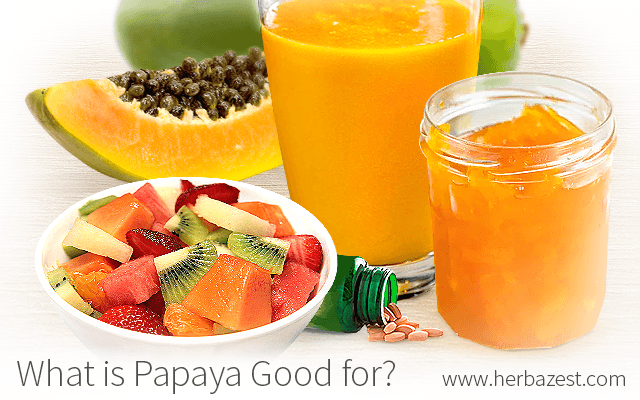The papaya fruit comes from a tropical tree-like plant, botanically called Carica papaya. Cultivated for hundreds of years, papaya has given way to a plethora of creative uses in food, cosmetics, herbal medicine, and so much more.
Most Common Uses of Papaya
Papaya is an extremely nutritive crop of important medicinal value. The most popular uses of papaya include its role in foods and herbal healthcare supplements.
Culinary uses
Although it is often served raw with simple slices of lemon or lime, many culinary uses of papaya fruit go much further.
Fresh papaya is good for fruit and veggie salads and as a dried, candied fruit. The whole fruit can also be seasoned and baked like a pumpkin. Additionally, there is a myriad of papaya food products on the market. While its nectar forms the base of tropical juice blends and smoothies, its flesh is a prerequisite of papaya-flavored ice creams, marmalades, and preserves.
Meanwhile, unripe, green papaya has a mild, subtle flavor. It is prepared in vegetable soups and curry dishes throughout southern Asia. Various other parts of the plant also hold culinary value: while thepapaya leaf is prepared in the same way as a spinach, papaya seeds have a peppery taste and are used to season salad dressings and other foods.
Medicinal uses
Papaya is a healthy, nutrient-rich antioxidant food. Numerous studies suggest its bactericidal power as well as its potential efficacy in preventing diabetes and heart disease.
Papaya-based health supplements claim to provide the main papaya benefits in a safe, medicinally-potent dosage. Many of papaya medicinal uses are focused on treating constipation, diarrhea, indigestion, parasites, and various other disorders. These uses revolve around papaya's enzyme papain, which is contained in high amounts in the latex of the unripe fruit and helps break down proteins, thus improving digestion. It has also been used to reduce inflammation caused by dental healthcare and surgery.
Less Common Uses of Papaya
The following uses of papaya are those which – while popular – are secondary to its role in food and medicine.
Cosmetic uses
With UV-protective carotenoids and powerful antioxidant effects in the body, the use of papaya for skin health is widely popular. It is an important ingredient in a number of commercial facemasks, body scrubs, and healing ointments. Papain or latex powders are often used for removing dead cells from the skin's surface, improving the appearance of wounds and scars, and even whitening teeth.
Industrial uses
Papaya latex is a product of interest when it comes to manufactured goods. Its most common applications include serving as an additive in chewing gums, meat tenderizers, and beer clarifiers. It is also used for cleaning silk and wool just prior to dyeing and removing hair from animal pelts.
Ornamental uses
The tropical papaya tree can be tall or short, depending on the variety. With its large canopy of horizontally-arranged leaves and fragrant, trumpet-shaped flowers, the papaya plant is an ornamental delight long after its fruits have been harvested.
Others
Traditional uses of papaya include making rope from the tree bark or using the leaves to fashion a mild, stain-removing detergent.
In remote regions of Mexico, the leaves are rolled and smoked as tobacco. Meanwhile, some other folk practices use papaya's latex as a contraceptive or skin treatment to remove freckles.
Papaya is a healthy, delicious herb of significant commercial value. Good for diverse meal recipes, cosmetic applications, and herbal dietary supplements, papaya uses its store of antioxidant, anti-inflammatory, and antibacterial nutrients to provide powerful medicinal action. There's no better time than the present to start discovering all the ways that papaya is good for you and your needs.
Sources
- Health and the Environment Journal, Papaya – An innovative raw material for food and pharmaceutical processing industry, 2013
- Purdue University, Carica papaya L. | Papaya, Carica papaya L.
- The University of Kansas, Foods indigenous to the western hemisphere
- University of Arkansas, Plant of the week: Papaya
- University of Hawaii, Papaya, General crop information




